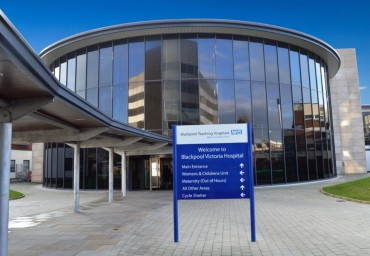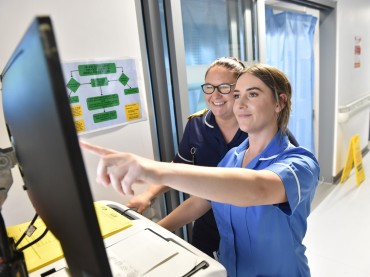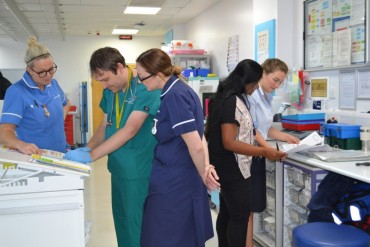A Medical Professional will have discussed with you tube feeding. This page will provide information in order to help you to understand this more clearly and make a decision.
The medical professional will have discussed the reasons why you have been asked to consider this as an option. Learning to cope with tube feeding at home is not always an easy process but your community team will provide as much support as you feel you need.
Should you be making a decision on behalf of someone else, you will have lots of differing emotions and questions. The team involved in making this decision will support you with this and offer guidance.
What does tube feeding involve?
Tube feeding is considered appropriate when an individual loses their ability to swallow or is unable to take sufficient nutrition or hydration to fully meet their needs. There are many different types of feeding tubes, and the tube that is right for you will be discussed with you.
The ways in which you receive your feed also differ and you will have the opportunity to decide on how your feed is received, in order that it best suits you.
On occasions there may be a reason why a feeding tube cannot be placed or can only be placed by a specific method for example surgically. All such aspects will be discussed prior to a final decision regarding the placement of a tube.
Nasogastric – A nasogastric tube (NG) is passed via your nose into your stomach, allowing feed, fluids and medications to be administered.
Nasojejunal – A nasojejunal tube (NJ) is passed via your nose into your small intestine (bypassing the stomach), allowing feed, fluids and medications to be administered.
Gastrostomy – A gastrostomy tube is placed directly into the stomach, allowing feed, fluids and medications to be administered ‘directly’ into your stomach.
Gastrojejunostomy – A gastrojejunostomy tube is a tube positioned into the stomach with an additional tube extending from it into the small intestine enabling us to administer feed, fluids and medications. These tubes are often used in individuals who suffer with sickness and reflux.
Jejunostomy – A jejunostomy tube is positioned directly into the small intestine, where feed, fluids and medications are administered.
It is important that enteral feeding fits around your lifestyle. Your dietitian will discuss options with you:
Pump Feeding
Pump feeding involves receiving feed that is administered via a pump using a ‘giving set’ which is attached to your tube. A lot of people prefer to feed overnight so they are free to undertake their normal activities during the day. Other people prefer to feed during the day and often carry their pump and feed in a special rucksack.
Bolus Feeding
Bolus feeding involves administering feeds using a syringe directly into the feeding tube, most often using gravity. The bolus feeds can be given at set times during the day, according to a person’s preference.
Combination Feeding
Some people prefer the flexibility of using both bolus feeds and a pump. This often reduces the amount of feed needed at each episode.
Can I still Eat and Drink?
If you have been assessed as safe to take food and drink via mouth then you can continue to do so with a feeding tube in place. Often a tube is placed when an individual is still eating and drinking as it is considered they may lose their ability to swallow at some point in the future
The effect on normal life by tube feeding will hopefully be minimal. The dietitian caring for you should aim to provide a feeding regime which has minimal effect upon your day to day life.
Normal activities such as showering, swimming, working, shopping, going out and going on holiday should not be affected by having a feeding tube in place. In fact, it may improve the experience of some of these activities. If there is something you do regularly and you are unsure you can do this with a tube in place then speak with your dietitian.
After the initial 4 weeks the tube tract should have become patent. If you have been advised to rotate your tube, it will now be safe to do so. You should rotate the tube each day by 360° rather than 180° and move it in and out by around 2-3cm rather than 1cm.
You will need to move the external fixator disc away from the site to enable you to clean and manage your tube. The stoma site (area of skin around the tube) should be cleaned daily using soapy water. The tube itself should also be kept clean. Always remember to wash your hands before cleaning the stoma site.
You are safe to shower as soon as your feeding tube has been placed (though it may be best to keep from washing the site at this time).
After 4 weeks and when the site is clean, you are safe to have a bath or go swimming.
Feeds
Your feeds can be delivered from your local pharmacy or from your feed company. Your dietitian will inform your GP of the feed prescription you require. This prescription can be dispensed from the feed company (who will need the prescription sending to them) or your local pharmacy and will be delivered to you.
Plastics – (Such as giving sets & tube ends)
These are delivered by your feed company, who will ring you each month to arrange what supplies you require. Any changes needed to your supply of plastics can be made by your dietitian.
Feeds
Your feeds can be delivered from your local pharmacy or from your feed company. Your dietitian will inform your GP of the feed prescription you require. This prescription can be dispensed from the feed company (who will need the prescription sending to them) or your local pharmacy and will be delivered to you.
Plastics – (Such as giving sets & tube ends)
These are delivered by your feed company, who will ring you each month to arrange what supplies you require. Any changes needed to your supply of plastics can be made by your dietitian.
Contact Numbers
P.I.N.N.T (Patients on Intravenous and Nasogastric Nutrition Therapy) is a support group for children and adults receiving Parenteral and enteral nutrition.
PINNT PO Box 3126
Christchurch
Dorset
BH23 2SX
Visit the PINNT website here or call 01202 481625.



